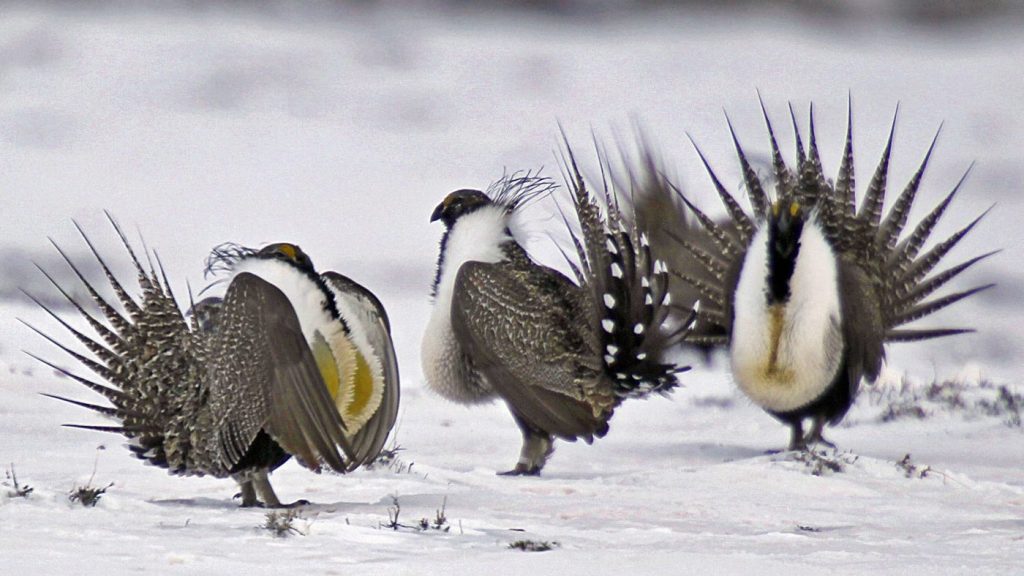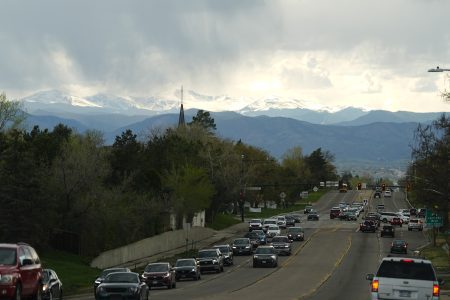The Bureau of Land Management (BLM) put out a plan on Thursday to prioritize the protection of greater sage-grouse on public lands, with the goal of reversing habitat loss for a well-known bird in the U.S. West and restoring the health of the ecosystems around it.
The proposal, a draft environmental impact statement, looks at various options for managing the greater sage-grouse habitat on BLM-administered public lands in 10 states: California, Colorado, Idaho, Montana, Nevada, North Dakota, Oregon, South Dakota, Utah and Wyoming.
Greater sage-grouse, recognized for their distinctive spiked feathers and bulky, round bodies, have been experiencing habitat loss due in part to the impacts of climate change, such as drought, more frequent wildfires, and invasive species, according to the BLM.
These birds, which once numbered in the millions but now total fewer than 800,000, depend on a type of shrub called sagebrush found in the Mountain West and may need as much as 40 square miles of uninterrupted landscape to remain healthy, as explained by the agency.
“The magnificence of the West and its way of life are at risk,” BLM Director Tracy Stone-Manning said in a statement. “Sagebrush lands are areas where people work and play, and they are the source of the main rivers in the West.”
Therefore, safeguarding sagebrush, a crucial source of food and habitat, is important not only for the birds, but also for other species, such as mule deer, pronghorns, and pygmy rabbits, as noted by the bureau.
The BLM manages the largest portion of sage-grouse habitat in the U.S., covering nearly 67 million acres of a total of 145 million acres.
The six options in the draft environmental impact statement are based on plans that the BLM put in place in 2015 and updated in 2019, while taking into account new scientific findings and adjusting for changing climate conditions.
When creating these options, the BLM took into consideration around 1,900 comments during an initial public scoping period, as well as information provided by federal, state, local, and tribal entities.
The preferred plan of action from the bureau, also known as the fifth alternative, focuses on balancing the conservation of greater sage-grouse with the use of public lands. This option lies between the most stringent protection plan and the option with the least restrictions on energy and mineral development.
The preferred option would allow for new fluid mineral leasing, with very few restrictions on surface occupancy in designated “Priority Habitat Management Areas.” New mining of saleable materials, including construction materials like sand, gravel, dirt, and rock, would be prohibited in most priority habitat areas, except for the expansion of existing pits.
For wind and solar development and major rights-of-way projects, this option would involve “less direct avoidance and provides more opportunities for considering compensatory mitigation” — creating habitat elsewhere to offset negative impacts.
The other five options in the draft offer a range of choices regarding mineral leases, oil and gas leasing, wind and solar facility development, livestock grazing, and management of wild horse and burro herds.
The strictest choice, the third option, would provide the strongest protections for greater sage-grouse. The BLM would close off its habitats to new mineral leasing and livestock grazing, while getting rid of overlapping wild horse and burro management zones.
While recognizing that this option would offer the most robust defense for sage-grouse, the BLM analysis emphasized it would also lead to 'making public lands unavailable to grazing' and require increased fencing to separate federal and nonfederal properties.
According to the analysis, these measures could lead to 'possible habitat fragmentation, increased collision risks, increased opportunities for [greater sage-grouse] predators.' Additionally, a decrease in grazing could result in a buildup of fine fuels and increase wildfire risk.
In reaction to the draft environmental impact statement, certain conservation and sportsmen’s groups praised what they considered 'a renewed commitment to safeguarding the intricate web of life supported by the sagebrush ecosystem.'
Alison Holloran, executive director of Audubon Rockies, emphasized the importance of taking the bird's steep decline seriously and making meaningful changes to conserve the bird and ensure a future for the West.
Bobby McEnaney, director of nature for Natural Resources Defense Council, described the greater sage-grouse as 'a bellwether for the entire Mountain West ecosystem.'
McEnaney stated that the urgently needed protections would greatly help in preventing the extinction of this iconic species and that further efforts are necessary to protect the sage grouse and the resources it depends on.
Kaden McArthur, government relations manager for Backcountry Hunters & Anglers, highlighted the importance of healthy sagebrush ecosystems for the survival of 'other species that rely on that core habitat such as pronghorn and mule deer.'
But representatives of other conservation groups criticized the bureau's preferred alternative selection, pointing out that other options favored millions more acres of protective designation.
Steve Holmer of the American Bird Conservancy expressed hope that some habitat will be protected, but stated that the proposed areas of critical environmental concern are too small to recover the sage grouse.
Randi Spivak, public lands policy director at the Center for Biological Diversity, emphasized that the BLM’s preferred option 'will fail these iconic birds once again and keep them on an extinction trajectory.'
Spivak added that this choice virtually does nothing to strengthen protections, ensuring the grouse will continue their downward spiral.









